|
Green Going into Winter...
Chris Tritabaugh, Northland Country Club, Duluth, MN:
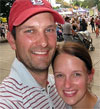 "Last fall I wrote on the subject of working to keep our turf green as we head into winter. You can read the post here. These photos of the putting green were taken this morning. Over the last few weeks of the season we work to keep the surfaces green, without being lush. This is absolutely key. Lush turf going into winter is a recipe for disaster. However, turf kept green through the use of ferrous sulfate and various colorants can be a real advantage come spring.
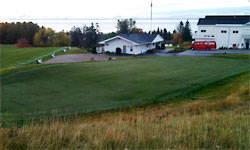
|
With our location near Lake Superior and the slow warm-up we get in the spring, anything we can do to the turf now to provide better spring growing conditions, will help to provide a better product early in the season.
Today's cold will probably just about bring a halt to any further top growth on our turf. Now the plants will focus their photosynthetic capabilities on making and storing carbohydrates in their root systems. A process we help to strengthen with our late season applications of nitrogen.
Top growth may have ceased but you can still enjoy some pretty darn good playing conditions. Come on out and enjoy."
Visit Chris's blog at northlandgrounds.blogspot.com.
|
 |
|
Fall Projects - Fairway Expansion...
Donald Cross, CGCS, Skokie Country Club, Glencoe, IL:
 "When we did our course restoration back in 1999-2001, Fairway Repositioning and Expansion was one of the objectives of our architect, Ron Prichard. We repositioned several and added about 1 1/2 acres of fairway turf. At the time this was all purchased bentgrass sod, and as an aside, it looked noticeably different from our mixed bentgrass/poa annua turf for many years. Cost was quite high and so many areas did not get the expansion that Ron originally envisioned.
Our plan at that time was to cut most of the proposed expansion areas, which includes areas close to the front sides or leading edges of bunkers, as well as the areas behind or the shoulder areas behind bunkers, as intermediate rough and to eventually convert these areas to fairway turf over time.
Several Expansion Areas remain throughout the course and you can see where we will eventually convert by looking at the width of the intermediate or short grass rough surrounding the fairways. Eventually we will have just a single width mower pass of 5' or less surrounding all fairways, except for a few areas at beginning of fairways such as #2. The wider areas toward the inside of the fairways will be converted from intermediate bluegrass/ryegrass to our own fairway turf of bentgrass/poa annua.
Back in 1999 I grew an entire 10,000 sg. ft. nursery from aeration cores collected from the greens. It's a simple and effective plant propagation technique that I had used twenty years prior to establish new bentgrass tees at a former golf course I managed. I actually had learned that this technique worked as a grounds crew worker at a country club during the summer of my college years. We had some damaged areas on the fairways and so we aerated healthy areas, collected cores, and spread and tamped them into the damaged areas. In a short time we were mowing and the damage was soon recovered.
Since then I've used this same technique to establish more nursery greens, ultimately used to "It is highly successful, relatively quick, inexpensive and most importantly, the resulting turf is an exact match of the turf species in the 'donor' area..." |
expand nearly all of our greens over time, as well as to establish the entire greens of #5 and #11. It is highly successful, relatively quick, inexpensive and most importantly, the resulting turf is an exact match of the turf species in the 'donor' area. In other words the turf in the expansions will look the same, perform the same (for better or worse), play the same as the original green or, in this case, fairway area. Using new seed or new sod, aside from taking longer to establish (seed) or cost significantly more money (sod), will most certainly yield a surface dissimilar to our existing fairway surfaces."

"Dimpling" cores into surface with knobby tires of bunker rake machine (also not shown was small amount of bentgrass seed dropped prior to dimpling process) to ensure good soil contact, followed by a thorough watering.
|
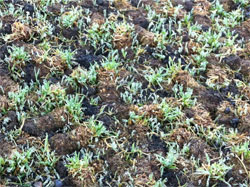
Close-up of cores and seed beginning to sprout less than a week later!
|
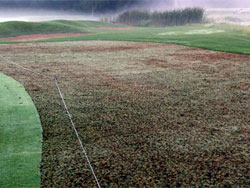
About 10 days after planting. Beginning to show nice progress.
|
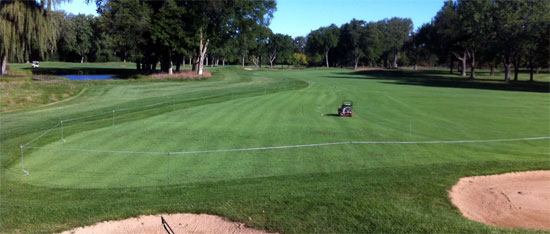
First mowing, 16 days after planting. Area looks like fully established from this short distance but will be a few more weeks before fully established and play is allowed. Great progress though!
|
Visit Don's blog at skokieturf.blogspot.com.
|
 |
|
Understanding Frost...
Jason Hooper, Quilchena Golf Club, Quilchena, BC:

Turf killed from traffic under frosty conditions.
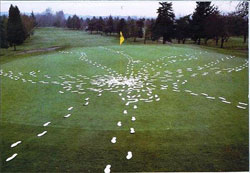
Footprints on a green from just one foursome.
|
 "We had our first frost delay of the fall season yesterday, 10 days earlier than our first one this time last year. As I suit up in my bulletproof vest and riot gear to deal with upset golfers on frosty mornings, I often wonder why some golfers just simply can't accept that golfing on frosty turf can cause damage. Plain and simple: TRAFFIC ON FROSTY TURF KILLS.
I am well aware that golfers here used to be permitted to play to temporary greens under frosty conditions, but this is no longer the case. When I arrived here over four years ago, I was given a mandate by the Golf Committee as per the Board of Directors to do whatever necessary to raise the standards of the Club to the level expected for a private Club. Simply playing to temporary greens doesn't mean damage to the turf is being avoided. I tend to think of it as turning a blind eye to vandalizing your own golf course.
Frost does not discriminate against what turf it develops on nor does the ensuing damage from traffic on it. Traffic on frosty turf will result in death whether it's a green, tee, fairway or rough. Implementing a Frost Delay Policy to protect the entire course, not just the greens, was an integral component of ensuring that our everyday turf conditions meet the high expectations of our members and guests. Here is an illustration that may help you understand the potential for damage from a single foursome of golfers:
With regards to frost, there is something very important that many golfers are not aware of. When we arrive at the course in the morning, it very well may be frost-free. Quite often frost develops as the sun begins to rise and can continue to develop into a heavier frost even after sunrise as the temperature tends to drop a bit. We do our best to update you with current course conditions as early and often as we can, but don't be surprised if the frost develops on the course while you are already on your way for your morning tee time.
Here are three general rules of thumb when it comes to predicting whether or not we will have frosty conditions:
- Frost typically occurs at temperatures of 4C or lower; it does not have to reach 0C as many believe.
- Clear skies increase the potential for frost; cloudy skies tend to "insulate" better, resulting in warmer air and surface temperatures.
- Wind also influences frost development. Windy conditions can prevent cold air from settling in, again resulting in warmer air and surface temperatures. That being said, if the wind temperature is below zero, it can be quite damaging to the turf.
There are other factors that determine whether or not frost will develop, but these three are the most accurate when it comes to predicting it.
I could go on and on explaining the damage caused from traffic on frosty turf, but I'll once again leave that to the USGA Green Section Record via this video."
Visit Jason's blog at qgolfclub.blogspot.com.
|
 |
|
Sod Stripper...
Bryan Boyer, Cinnabar Hills Country Club, San Jose, CA:
 "The turf on 9 Lake is officially dead and we put new sod in today while the Lake course was closed. Being that the majority of the dead areas are less than 3" wide (see Course Vandalism), we used a 3" sod stripper which turned out to be a great tool.
Since we don't have one, I leaned on our neighbor John Redmond of Almaden Country Club to borrow his. Just another reminder how nice our profession can be considering what led to this situation. Thanks John!
I will be purchasing our own this week knowing that this world isn't short on #*$@^s."
Visit Bryan's blog at cinnabarhills.blogspot.com.
|
 |
|
Golf Course Cultural Practices...
David Dore-Smith, Copperleaf Golf Club, Bonita Springs, FL:
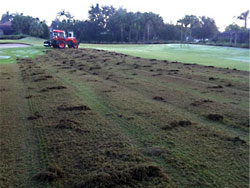
Verticutting of fairways.
|
 "Our golf course closures have finished for the year and the onset of cooler, drier weather will soon be here. There was a multitude of work completed on the course during the closures including verti-cutting and aerification of the greens, aerification, verti-cutting and top-dressing of all tees, aerification, verti-cutting and top and verti-cutting and aerification of all roughs.
All of this work is carried out 'in-house' by our trained staff using our equipment. It takes an immense amount of co-ordination and communication with all staff members to complete the work on schedule and still provide sufficient time for the turf to recover and be in a playable condition upon re-opening.
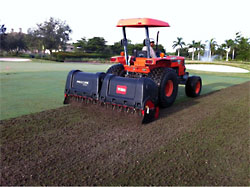
Aerification of fairways.
|
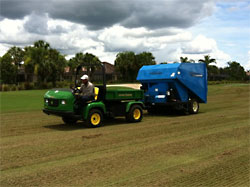
Vacuuming of fairways.
|

Circle cutting and final clean up of fairways.
|
The benefits of these practices are numerous, including improved turf rooting, penetration of rain and irrigation water into the soil, oxygen exchange in the soil profile, improved fertility uptake, smoothness of the playing surface, improved green speed, reduction in disease pressure, thatch reduction and overall improvement in playability for all golfers.
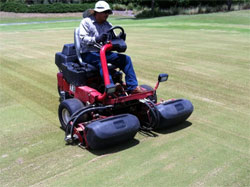
Verticutting of Greens.
|
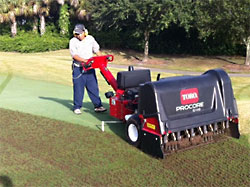
Aerification of greens.
|
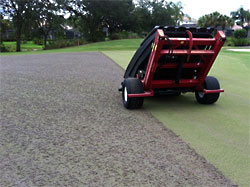
Core clean up on greens.
|
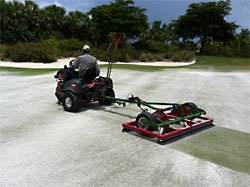
Dragging of sand into the core holes on the greens.
|
|
Without question, the cultural practices carried out on the course can easily be frowned upon by most golfers, not only here at Copperleaf, but at every golf course throughout the world. From a management point of view, I too, dislike seeing the turf grass disturbed so much. It is by far one of the most challenging times of year; however,I know that the work carried out now will provide the highest chance of success during periods of turf stress and high golf play. I appreciate the patience of our year round golfers during these times and to please understand that these procedures are for the betterment of the course.
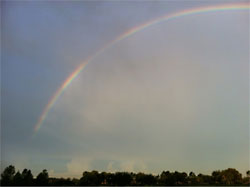
A little luck never hurts!
|
As always, Mother Nature plays an important role in the success of the operation. Any rainfall can slow the entire process down and make it extremely difficult to brush sand into the greens, drag the aerification plugs to break up the soil and to vacuum the verti-cuttings.
However, with the teamwork of our entire staff, the ability of our mechanics to keep everything operating safely, and a little luck; everything always seems to get completed on time."
Visit David's blog at www.copperleafgcm.com/
|
 |
|
The Frost is on the Pumpkin...
John Slade, Laurel Creek Country Club, Mt. Laurel, NJ:
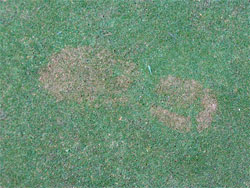
|

"How can a footprint be a killer?
When it's a footprint made on a putting surface that's covered with frost. It may be hard to believe that simply walking across a golf green covered with frost can cause so much damage, but the evidence will be there in a few days as the turfgrass dies and leaves a trail of brown footprints. That's why most courses will delay starting times until the frost has melted. And it's also why golfers who appreciate a quality putting surface will be patient during frost delays.
Why does frost cause problems?
The putting surface, or green, is an extremely fragile environment that must be managed carefully. Remember that every green is a collection of millions of individual grass plants, each of which is a delicate living thing. Obviously, Mother Nature never meant for these plants to be maintained at 1/8 or even 1/10 of an inch for prolonged periods. This stress makes greens constantly vulnerable to attacks from insects, disease, heat, drought, cold -- and frost.
Frost is essentially frozen dew. It can form when the temperature (or wind chill) is near or below the freezing point. The ice crystals that form on the outside of the plant can also harden or even freeze the cell structure of the plant. When frosted, the normally resilient plant cells become brittle and are easily crushed. When the cell membranes are damaged, the plant loses its ability to function normally. It's not much different than cracking an egg. Once the shell is broken, you can't put it back together.
The proof is in the prints.
Although you won't see any immediate damage if you walk on frosted turf, the proof will emerge within 48 to 72 hours as the leaves die and turn brown. And, since just one foursome can leave several hundred footprints on each green, the damage can be very extensive.
Thanks for understanding.
The damage isn't just unsightly -- putting quality will also be reduced until repairs are made. Those repairs are time-consuming and, in extreme cases, the green may have to be kept out of play for days or weeks until the new turfgrass is established. A short delay while the frost melts can preserve the quality of the greens, prevent needless repairs and may even save you a few strokes the next time you play."
Visit John's blog at laurelcreeksuper.blogspot.com.
|
 |
|
Play Time Is Over...
David Smith, Fawn Lake Country Club, Spotsylvania, VA:
 "A mole has been terrorizing 6 green for the past week. Attempts to stop it have yet to work, but we're not going to give up. Once we feel confident that the damage has stopped, we'll make permanent repairs to the area.
If it's not one thing it's another..."
Visit David's blog at flccturfcare.blogspot.com.
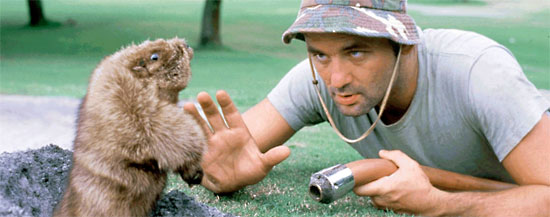
|
 |
 |
|
About our Blog Aggregator: Many superintendents are now hosting private blogs to better communicate with their golfers and/or members. Beyond local weather and course conditions, there is a great deal of information about projects, methodologies and techniques that would be of value to other superintendents — hence our Turf Blog Aggregator. As every blogger struggles occasionally with content, we also include posts intended to educate golfers about turf maintenance for others to use as a template for their own blogs.
Miss any previous issues of TBA? You can find them all here.
Turf Blog Aggregator(TM) is a trademark of Turnstile Media Group.
|
|